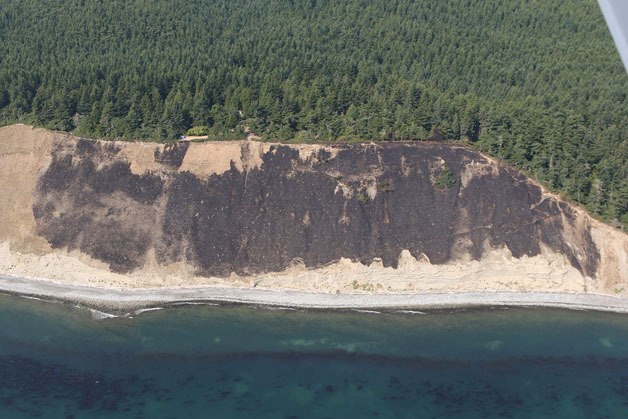Jon Crimmins was attending a meeting at Deception Pass State Park Wednesday when he got a call that one of the Whidbey Island state parks he manages was being threatened by a brushfire.
Crimmins, area manager for Central Whidbey State Parks, didn’t know what to think since it was the second brushfire reported at Fort Ebey State Park in five days.
Crimmins got to the scene, walked past firefighters and peered over a steep hillside to get a look at the precarious situation for himself.
What he saw was a blackened slope of scorched earth and flames traveling along the lower bluff out of reach of fire hoses.
Firefighters from four different agencies worked together to prevent the challenging brushfire from threatening the forest and campgrounds.
By the time the fire was contained by early evening, with help from air support, it had burned roughly 10 acres and left an impression in Crimmins’ mind about how well firefighters from different agencies worked together to protect a recreational treasure.
“Without them, we’d be lost,” Crimmins said.
Wildland firefighters from the Washington Department of Natural Resources worked into the evening providing support from ground and air to further contain the fire that was largely under control by the time DNR arrived.
Firefighters from North Whidbey Fire and Rescue, Central Whidbey Fire & Rescue and Navy Region Northwest Fire and Emergency Services were the first to respond to the 3:10 p.m. call and knocked down most of the flames by the time DNR’s ground crew got to the site about 90 minutes later.
The fire was started by a youth playing with a lighter in the group campground area, said Mike Brown, deputy fire chief with North Whidbey Fire, the first responding agency that got to the scene in 11 minutes and set up incident command for the mutual aid call.
The steep grade and difficult access to fight the fire made the situation uniquely challenging and kept firefighters concerned about not letting the brushfire spread beyond their reach.
Firefighters set up a perimeter at north and south ends of the blaze to try to keep the fire “in a box” and stop flames from spreading out of containment toward areas of greater risk to people and structures, Brown said.
Some crews had to lay hose down along walking trails and cut their own paths through thick brush to get a nozzle over the cliff edge to knock down flames.
“Access was very, very difficult,” Brown said.
“It was really difficult to extinguish the fire due to the placement of where it was.”
Since DNR’s crews are based in Sedro-Woolley, local fire agencies on the island sometimes handle small fires on state lands without the need of assistance, Brown said.
However, the significance of Wednesday’s fire prompted an immediate call to get DNR involved, and ground crews had to travel from a fire in Whatcom County to get to Central Whidbey.
“It’s been busy for early July,” said Albert Kassel, DNR’s fire investigator who was on the scene.
“It’s extremely dry this year.”
Central Whidbey Fire worked with the naval unit to tackle the south side of the perimeter, while North Whidbey Fire handled much of the north side with assistance from naval personnel.
“You need anything?” one North Whidbey firefighter asked Capt. Steve Lacy as he kept an eye on the flames on the bluff below.
“How about a chopper full of water,” Lacy responded.
Lacy got his wish around 5:40 p.m. when the helicopter arrived after traveling from Ellensburg and soon started dropping buckets of sea water on the fire.
North Whidbey Fire soon began pulling out its crew and transitioning control of the fire to DNR but kept a water tender on the scene to provide support until 9:40 p.m., Brown said.
DNR was still onsite Friday monitoring the scene, which will continue to smoke possibly for weeks because of hot spots, Crimmins said.
The fire started along a trail near the group campground by a youth from a visiting, off-island youth group.
Any multi-agency response is costly but that cost rises possibly by “tens of thousands of dollars” by the presence of air support, Brown estimated.
If the fire is found to be started deliberately, parents can be hit with a bill to pay for costs associated with fighting the fire, said Janet Pearce, communications officer with DNR.
A juvenile also may be sent to counseling programs, Brown said.
Another smaller brushfire on the bluff caused by a firework happened July 3 but managed to burn itself out overnight with no emergency calls made to alert firefighters, Crimmins said.
Overall, Brown said he was pleased by efforts by all involved to keep the fire from spreading laterally out of containment.
“The response was great,” Brown said. “With mutual aid, we all work very well together.”


